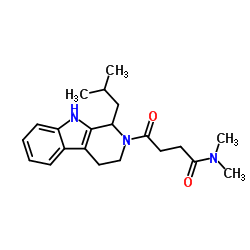Involvement of loops L2 and L4 of ribonucleolytic toxin restrictocin in its functional activity.
Punyatirtha Dey, Manisha Tripathi, Janendra K Batra
Index: Protein Pept. Lett. 14(2) , 125-9, (2007)
Full Text: HTML
Abstract
Restrictocin, a member of the fungal ribotoxin family, specifically cleaves a single phosphodiester bond in the 28S rRNA and potently inhibits eukaryotic protein synthesis. The long loops in restrictocin molecule have been shown structurally to be involved in target RNA recognition. In this study we have investigated the role of some putative substrate-interacting residues in loops L2 and L4, spanning residues 36-48 and 99-117, respectively in restrictocin catalysis. The residues Lys42, Ser46, Pro48 and Lys111 were individually mutated to alanine to probe their role in restrictocin function. The mutation of Lys111 to alanine, although did not affect the ribonucleolytic activity, rendered the toxin completely inactive in inhibiting translation in HeLa cells as well in an in vitro cell free system. The loop L4 in restrictocin appears to be more critical compared to loop L2 for its interaction with the specific substrate.
Related Compounds
| Structure | Name/CAS No. | Molecular Formula | Articles |
|---|---|---|---|
 |
Restrictocin
CAS:1406-72-0 |
C21H29N3O2 |
|
The ribotoxin restrictocin recognizes its RNA substrate by s...
2011-04-12 [Biochemistry 50(14) , 3004-13, (2011)] |
|
Role of individual cysteine residues and disulfide bonds in ...
1999-08-03 [Biochemistry 38(31) , 10052-8, (1999)] |
|
Mechanism of specific target recognition and RNA hydrolysis ...
2001-08-07 [Biochemistry 40(31) , 9115-24, (2001)] |
|
Electrostatic interactions guide the active site face of a s...
2008-08-26 [Biochemistry 47(34) , 8912-8, (2008)] |
|
[Antibody detection in patients with invasive aspergillosis]...
2004-01-01 [Mycoses 47 Suppl 1 , 55-9, (2004)] |